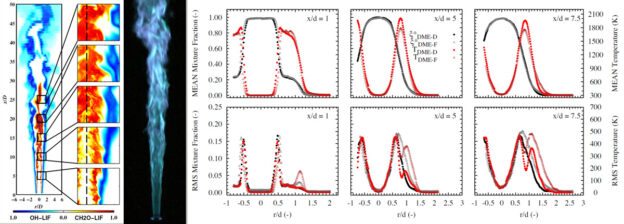Sandia/Ohio State/TU Darmstadt
General Description: The motivation for these experiments was to extent the database for model target cases to more complex fuels than previously considered. DME is an oxygenated fuel that has some potential a sustainable fuel alternative or additive for Diesel combustion. It is the simplest ether and oxygenation make it less prone to soot formation than C2 hydrocarbons, which is beneficial for species measurements by Raman scattering. On the other hand, DME undergoes low temperature chemistry, and mole fractions of hydrocarbon combustion intermediates are much higher than in comparable methane flames. This complicates interpretation of the Raman data because, for the data presented here, the Raman system at Sandia used just a single channel for the CH-stretch region of the Raman scattering spectrum. Therefore, the individual hydrocarbon intermediates could not be distinguished from the parent fuel. To compensate for this lack of information, Frederik Fuest developed an approach to DME data analysis in which laminar flame calculations were used to help interpret signals, and a modified definition of the Bilger mixture fraction was used. Details are explained in Fuest et al. (2012), which documents the development of this approach and its application to data from initial exploratory experiments on two piloted DME/air flames (not the flames presented here). The same Raman data analysis approach was applied to later experiments on the flames reported here, so the Fuest et al. (2012) paper is important for understanding of the data. One consequence of this approach is that results are reported as mole fraction and cannot be easily converted to mass fractions. Therefore, comparisons with simulations should be done on the basis of mole fractions rather than mass fractions. Additional explanation of this issue is included in the data download.
The piloted DME flame series was developed by Coriton et al. (ProCI 2015) as an analog to the familiar Sandia piloted methane/air flames D,E,F (Barlow and Frank, ProCI 1998). The flames were stabilized on the Sydney piloted burner. The pilot was operated with a five-gas feed (C2H2, H2, air, CO2, N2) in proportions to yield the same adiabatic equilibrium product temperature and composition as that of a DME/air flame at 0.6 equivalence ratio. The DME/air ratio of the main jet was selected to give the same stoichiometric value of mixture fraction, 0.35 as for the piloted methane flames, and flame DME D had the same bulk velocity as piloted methane flame D. There were four flames in the original series, having jet Reynolds numbers ranging from 29,300 to 73,250. Coriton et al. reported stereo PIV measurements of velocity, as well as PLIF measurements of OH and CH2O, while Fuest et al. (2015) reported measurements of temperature and major species by Raman/Rayleigh/CO-LIF. Some of the experimental data have only been published in the context of comparisons with simulations by Neuber et al. (CNF 2019).
References:
- F. Fuest, R.S. Barlow, J.-Y. Chen, A. Dreizler, Raman/Rayleigh scattering and CO-LIF measurements in laminar and turbulent jet flames of dimethyl ether, Combust. Flame 159 (2012) 2533–2562.
http://dx.doi.org/10.1016/j.combustflame.2012.06.017 - B. Coriton, M. Zendehdel, S. Ukai, A. Kronenburg, O.T. Stein, S.-K. Im, M. Gamba, J.H. Frank, Imaging measurements and LES-CMC modeling of a partially-premixed turbulent dimethyl ether/air jet flame, Proc. Combust. Inst. 35 (2015) 1251–1258. http://dx.doi.org/10.1016/j.proci.2014.06.042
- F. Fuest, G. Magnotti, R.S. Barlow, J.A. Sutton, Scalar structure of turbulent partially-premixed dimethyl ether/air jet flames, Proc. Combust. Inst. 35 (2015) 1235–1242. http://dx.doi.org/10.1016/j.proci.2014.07.062
- G. Neuber, F. Fuest, J. Kirchmann, A. Kronenburg, O.T. Stein, S.G. Lopez, M.J. Cleary, R.S. Barlow, B. Coriton, J.H. Frank, J.A. Sutton, Sparse-Lagrangian MMC modelling of the Sandia DME flame series Combust. Flame (in review).
Please also include a reference to https://tnfworkshop.org in publications.
Primary Contacts: Robert Barlow ([email protected]), Jonathan Frank ([email protected])
Acknowledgments: See individual papers for funding acknowledgments.
Data Archive: The data archive and documentation are under construction. Please contact us to gain access to the preliminary archive.
